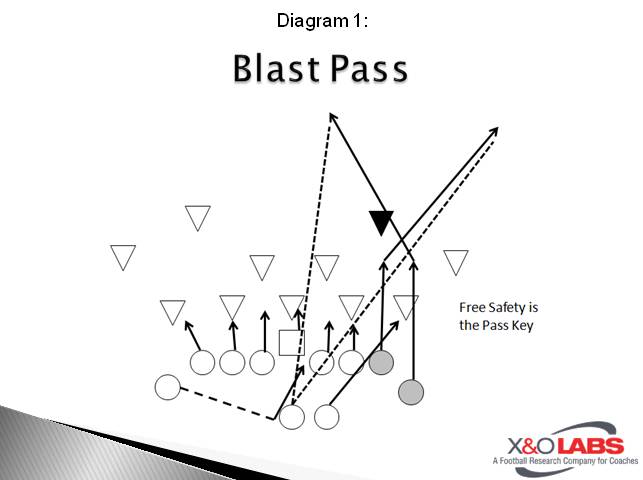By Michael Harrison
Head Coach
Wilde Lake High School (MD)
Introduction
At Wilde Lake our offense has made a transition into the gun double wing for approximately 90% of our snaps this past season. We had experimented with the inside zone read from spread sets, but the spread offense did not fit the well with our athletes abilities and skill sets. The decision was made to return to the double wing that we had run in the past, while retaining elements from the spread that were effective for us including the run pass options that place defenders in great reaction conflict. We wanted our quarterback to remain a running threat to the opposing defenses and not just be employed as a lead blocker as we had done in the past with the traditional double wing. The result was the transition to the gun double wing including the ability to run pre snap option plays as part of our concepts.
Blast, Blast Keep, Blast Follow and Blast Pass
The first pre snap option concept can be run from either the power or blast run plays. When the quarterback was moved into the gun we lost the ability to use the quarterback as a lead blocker on the power or blast. With one less blocker at the point of attack we made the decision to give the quarterback the ability to read the back side edge defender and assigned the backside tight end to reach up to the second level and block the alley defender.
The pass phase of the play occurs before the start of the play with a pre-snap read. If the pre snap read favors the pass then an audible is used to call the play action pass route paired with the blast play. The play action pass will involve the play side wing and tight end running a combination or crossing route with a play fake from the motion wing.

At the snap of the ball, the quarterback’s eyes the back side edge defender usually a defensive end. If that defender is taking an angle of pursuit to catch our wing from behind, then the quarterback pulls the ball out of the mesh and runs off tackle back side. If the edge defender stays home the quarterback simply gives the ball to the motion wing on the blast. The block of the back side tight end becomes important as it is the block on the last defender able to prevent the ball carrier from scoring.

Another wrinkle that we add to the blast or power read is the follow play. This is a very simple install with the quarterback faking the blast or power and following the wing through the same point of attack. This change gives the quarterback three lead blockers in the hole and often leads to a big play as we have more blockers at the point of attack than the defense has defenders.
Blast Blocking Rules:
QB: Pre-snap read to determine if the pass option is available. Mesh the ball with the motion wing. Eye the back side DE and pull the ball only if he is chasing the motion wing.
FB: Lead the wing through the hole and block the most dangerous 2nd level defender.
PSW: Step behind the blocks of the play side tackle and tight end. Lead the wing through the hole and block the most dangerous 2nd level defender.
PSTE: Block out on the widest man on the line of scrimmage.
PST: Block out on the first defender head up or outside.
PSG: Block down on the first defender on the line of scrimmage head up or inside.
C: Block any man on you or backside from the point of attack.
BSG: Block out on the first defender head up or outside
BST: Block out on the first defender head up or outside
BSTE: Attack the back side alley defender. Stay on the block.
BSW: Deep motion to the mesh point with the quarterback. Follow the FB and Wing blocks.
To study game cutups of the Blast RPO concept, click on the video below:
Head Coach
Wilde Lake High School (MD)
Introduction
At Wilde Lake our offense has made a transition into the gun double wing for approximately 90% of our snaps this past season. We had experimented with the inside zone read from spread sets, but the spread offense did not fit the well with our athletes abilities and skill sets. The decision was made to return to the double wing that we had run in the past, while retaining elements from the spread that were effective for us including the run pass options that place defenders in great reaction conflict. We wanted our quarterback to remain a running threat to the opposing defenses and not just be employed as a lead blocker as we had done in the past with the traditional double wing. The result was the transition to the gun double wing including the ability to run pre snap option plays as part of our concepts.
Blast, Blast Keep, Blast Follow and Blast Pass
The first pre snap option concept can be run from either the power or blast run plays. When the quarterback was moved into the gun we lost the ability to use the quarterback as a lead blocker on the power or blast. With one less blocker at the point of attack we made the decision to give the quarterback the ability to read the back side edge defender and assigned the backside tight end to reach up to the second level and block the alley defender.
The pass phase of the play occurs before the start of the play with a pre-snap read. If the pre snap read favors the pass then an audible is used to call the play action pass route paired with the blast play. The play action pass will involve the play side wing and tight end running a combination or crossing route with a play fake from the motion wing.

At the snap of the ball, the quarterback’s eyes the back side edge defender usually a defensive end. If that defender is taking an angle of pursuit to catch our wing from behind, then the quarterback pulls the ball out of the mesh and runs off tackle back side. If the edge defender stays home the quarterback simply gives the ball to the motion wing on the blast. The block of the back side tight end becomes important as it is the block on the last defender able to prevent the ball carrier from scoring.

Another wrinkle that we add to the blast or power read is the follow play. This is a very simple install with the quarterback faking the blast or power and following the wing through the same point of attack. This change gives the quarterback three lead blockers in the hole and often leads to a big play as we have more blockers at the point of attack than the defense has defenders.
Blast Blocking Rules:
QB: Pre-snap read to determine if the pass option is available. Mesh the ball with the motion wing. Eye the back side DE and pull the ball only if he is chasing the motion wing.
FB: Lead the wing through the hole and block the most dangerous 2nd level defender.
PSW: Step behind the blocks of the play side tackle and tight end. Lead the wing through the hole and block the most dangerous 2nd level defender.
PSTE: Block out on the widest man on the line of scrimmage.
PST: Block out on the first defender head up or outside.
PSG: Block down on the first defender on the line of scrimmage head up or inside.
C: Block any man on you or backside from the point of attack.
BSG: Block out on the first defender head up or outside
BST: Block out on the first defender head up or outside
BSTE: Attack the back side alley defender. Stay on the block.
BSW: Deep motion to the mesh point with the quarterback. Follow the FB and Wing blocks.
To study game cutups of the Blast RPO concept, click on the video below:









